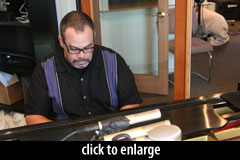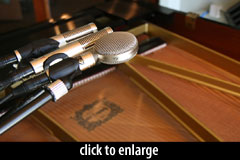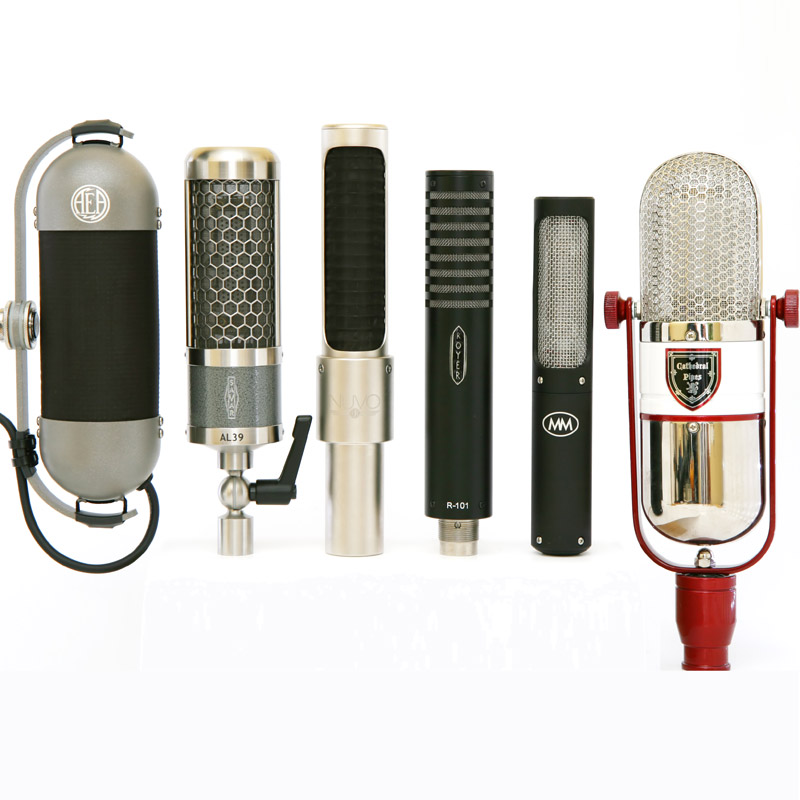
Ribbon Mic Shootout for Wired Magazine
Wednesday, January 12th, 2011 | by matthew mcglynn
 I had the pleasure of working with Wired writer Matthew Shechmeister on his review of ribbon mic mods, recently published on the Wired Magazine website.
I had the pleasure of working with Wired writer Matthew Shechmeister on his review of ribbon mic mods, recently published on the Wired Magazine website.
As he described, we put together a test to try to understand whether ribbon-mic modifications, whether DIY or professional, would really affect the mic’s sound. Read on for full details on the mics, the mods, and the missing audio files.
Background on the ribbon shootout
I had three imported ribbon mics that all share the same underlying transducer design. The only difference between these three mics was the size, shape, and construction of the “headbasket” surrounding the ribbon element. These seemed like great candidates for a 3-way shootout.
Mic #1 was a stock  TNC Audio ACM-3.
TNC Audio ACM-3.
Mic #2 was also an ACM-3, but I swapped the stock transformer for a retrofit unit from Oliver Archut at AMI/Tab-Funkenerk. His TR22 transformer was made as a drop-in replacement for ACM-3 and similar ribbon mics; read more about the it on Terry Manning’s Bulldog Audio Ribbon Transformers site.
(If you want to try your hand at a transformer swap, check out this step-by-step pictorial HOWTO: swapping ribbon-mic transformers.)
Mic #3 was a  TNC Audio ACM-2, which I sent to Stephen Sank of Talking Dog Transducer Company (and, more recently, Cloud Microphones) for an upgrade. Stephen cut and corrugated a new ribbon using NOS ribbon material that was surplus from his father’s tenure at RCA, and as the Wired article points out, he swapped the stock transformer for a Cinemag unit.
TNC Audio ACM-2, which I sent to Stephen Sank of Talking Dog Transducer Company (and, more recently, Cloud Microphones) for an upgrade. Stephen cut and corrugated a new ribbon using NOS ribbon material that was surplus from his father’s tenure at RCA, and as the Wired article points out, he swapped the stock transformer for a Cinemag unit.
In summary, the three mics covered the full range of common mods:
- Stock
- DIY transformer upgrade
- Ribbon and transformer upgrade
Can you hear the difference?
 I took all three mics to Banquet Studios, where composer and engineer Darryl Webb helped me put them through their paces.
I took all three mics to Banquet Studios, where composer and engineer Darryl Webb helped me put them through their paces.
Here is my disclaimer about shootouts — and my response to John Vanderslice, who is described in the Wired piece as “skeptical about whether shootouts reveal much about the quality of a piece of equipment.” I think shootouts are valuable for comparing microphones, especially if one of the mics is familiar. Listening to any single audio track in isolation communicates very little about how that microphone performed, but if a second audio track is provided as a reference, and the second track was made with a mic I know, then the comparison lets me draw some useful conclusions.
 Needless to say, shootouts are flawed by design. You either record one performance with many mics, and accept that each mic’s slightly different position will necessarily affect the outcome, or you can record multiple performances with one mic at a time in exactly the same place, and accept that performance differences will affect the outcome. The listener should always take these factors into account.
Needless to say, shootouts are flawed by design. You either record one performance with many mics, and accept that each mic’s slightly different position will necessarily affect the outcome, or you can record multiple performances with one mic at a time in exactly the same place, and accept that performance differences will affect the outcome. The listener should always take these factors into account.
 Shechmeister’s summary nails it: “A user can only develop a real understanding of a mic’s performance by putting it to work in dozens of sessions with diverse kinds of music.” I agree completely. But I recognize that this is impossible for most mics you don’t already own, so I regularly set up shootouts that attempt to reveal some sonic characteristics even in this imperfect world.
Shechmeister’s summary nails it: “A user can only develop a real understanding of a mic’s performance by putting it to work in dozens of sessions with diverse kinds of music.” I agree completely. But I recognize that this is impossible for most mics you don’t already own, so I regularly set up shootouts that attempt to reveal some sonic characteristics even in this imperfect world.
 We hung all three mics side-by-side, as close together as possible, above the studio’s grand piano, and matched their gain levels as closely as possible — as I recall, the mics’ output level differences were minimal. (All are passive ribbons, and need a lot of preamp gain.) We used the studio’s stock Digi-002 inputs.
We hung all three mics side-by-side, as close together as possible, above the studio’s grand piano, and matched their gain levels as closely as possible — as I recall, the mics’ output level differences were minimal. (All are passive ribbons, and need a lot of preamp gain.) We used the studio’s stock Digi-002 inputs.
Audio Samples
[audio:http://recordinghacks.com/sounds/samples/wired-ribbons/ACM2-Sank.mp3] [audio:http://recordinghacks.com/sounds/samples/wired-ribbons/ACM3-stock.mp3] [audio:http://recordinghacks.com/sounds/samples/wired-ribbons/ACM3-transformer.mp3](Find the 24-bit WAV audio files in the Wired article.)
“At The Museum”
The music in the samples is an excerpt from Darryl’s original piano composition called “At The Museum,” a full production of which you can hear here:
Credits
Thanks to Oliver Archut for the transformers and technical assistance, Stephen Sank for modding awesomeness, Darryl Webb for a great performance and patience in the studio, to Banquet Studios for access to the space, and to Matthew Shechmeister for shining some glorious light on a beloved niche within this tiny corner of the universe about which so few of us obsess so much.
Tags: darryl webb, oliver archut, Terry Manning
Posted in Uncategorized | 5 Comments »



Nick Malone
January 12th, 2011 at 12:35 pm
Anyone else catching a little bit of buzz on mic #1? Without knowing more details about the general setup, I’m hesitant to pin that specifically on the mic.
Nick Malone
January 12th, 2011 at 12:38 pm
Actually…I take it back! I was hearing it on my first listen, but after refreshing the page (by accident!) it seems to be gone. Odd!
Jed Jorgensen
January 12th, 2011 at 12:40 pm
I love these kinds of shootouts. For me they always underscore the importance of performance and placement versus the gear itself.
On my sennheiser headphones here at work (not ideal listening, but real world, right?) I thought the stock mic sounded the best for the recording. It seemed “clearer” in its presentation of the rhythmic information.
Thanks for doing this and for hosting such a great site!
thatgtrguy
January 12th, 2011 at 1:10 pm
I don’t know about better or worse. But I think the stock mic’s sound held up just fine. I wouldn’t have an objection to using any of the sounds from this shootout.
Justin Colletti
April 18th, 2012 at 5:32 pm
Nice roundup as always Matthew. I wasn’t an enormous fan of the ACM-2, which I felt got a little sloppy and murky near the bottom for this recording.
Both versions of the ACM-3s were nice, and I felt the difference between them was more slight than the difference between them and the ACM-2.
Both of the ACM-3s felt a little cleaner and better controlled than the other model. I felt like the modded version of the ACM-3 may have had a slightly more extended and rich bottom-end, but it was very subtle, if I heard it at all.